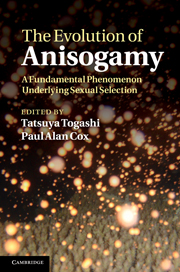Book contents
- Frontmatter
- Contents
- Contributors
- Introduction: The evolutionary mystery of gamete dimorphism
- 1 The origin and maintenance of two sexes (anisogamy), and their gamete sizes by gamete competition
- 2 The evolutionary instability of isogamy
- 3 Contact, not conflict, causes the evolution of anisogamy
- 4 Nucleo-cytoplasmic conflict and the evolution of gamete dimorphism
- 5 Adaptive significance of egg size variation of aquatic organisms in relation to mesoscale features of aquatic environments
- 6 Gamete encounters
- 7 Evolution of anisogamy and related phenomena in marine green algae
- Index
- References
1 - The origin and maintenance of two sexes (anisogamy), and their gamete sizes by gamete competition
Published online by Cambridge University Press: 19 May 2011
- Frontmatter
- Contents
- Contributors
- Introduction: The evolutionary mystery of gamete dimorphism
- 1 The origin and maintenance of two sexes (anisogamy), and their gamete sizes by gamete competition
- 2 The evolutionary instability of isogamy
- 3 Contact, not conflict, causes the evolution of anisogamy
- 4 Nucleo-cytoplasmic conflict and the evolution of gamete dimorphism
- 5 Adaptive significance of egg size variation of aquatic organisms in relation to mesoscale features of aquatic environments
- 6 Gamete encounters
- 7 Evolution of anisogamy and related phenomena in marine green algae
- Index
- References
Summary
INTRODUCTION
It is generally assumed (e.g. Maynard Smith, 1978; 1982) that ancestrally, gametes were small and isogamous (monomorphic). The evolution of anisogamy (gamete dimorphism) is a crucial transition in evolution (Maynard Smith and Szathmáry, 1995): it represents the evolution of the two sexes, males and females. Following Parker et al. (1972), I favor defining a sex in relation to the type of gamete a sexual phenotype carries. A sex is thus an adult phenotype defined in terms of the size of (haploid) gamete it produces: in an anisogamous population, males produce microgametes and females produce macrogametes. A simultaneous hermaphrodite is thus both male and female simultaneously, and a sequential hermaphrodite transforms sequentially from male to female (or vice versa). This definition of a sex differs from one that defines a sex in terms of gamete mating types (e.g. Wiese, 1981; Hoekstra, 1990). Under the Parker et al. definition of a sex in terms of gamete size, a mating type is not considered to be a sex, but simply a gametic type (that may or may not be related to gamete size) that shows a preference for fusion with certain other gamete types. In isogamous populations, there is thus one sex (though there may be several mating types). Retaining the definition of a sex for an adult phenotype that produces a given gamete size, and a mating type for a gamete phenotype that has a given characteristic for selective fusion may serve to remove some of the confusions that have arisen in the literature.
- Type
- Chapter
- Information
- The Evolution of AnisogamyA Fundamental Phenomenon Underlying Sexual Selection, pp. 17 - 74Publisher: Cambridge University PressPrint publication year: 2011
References
- 21
- Cited by

